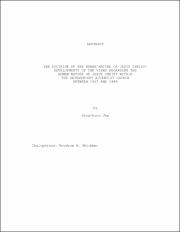| dc.description.abstract | The main purpose of this study is to trace and
describe the historical developments of the (three major)
views regarding the human nature of Jesus Christ with the
Seventh-day Adventist Church between 1957 and 1988. The
subsequent purposes, which this study tries to pursue, are
to identify major views, to define their main theological
points, and to classify their respective proponents or
advocates.
This study is structured to accomplish the purposes
outlined above. Chapter 1 is devoted to an introduction to
the dissertation.
Chapter 2 traces the developments of the views of
the human nature of Jesus Christ prior to 1957. The “New
Theology” View, which taught the sinless human nature of
Jesus Christ, developed through certain preliminary,
expansive, and decisive developments and events between 1949
and the release of Questions on Doctrine in November 1957.
This period can be identified as the era of the debate
between the sinful and sinless human nature views.
Chapter 3 focuses on the developments of the views
from 1957 (after the publication of Questions on Doctrine)
to 1971 (the year of the release of Movement of Destiny).
This period can be identified as the era of the debate
between the Traditional (“Post-Fall”) View, as thesis, and
the “New Theology” (“Pre-Fall”) View, as antithesis.
Chapter 4 is devoted to the period from 1971 (after
the publication of Movement of Destiny) to 1988 (the year of
the publication of Seventh-day Adventists Believe . . .).
This period can be identified as the era of the debate
between the Alternative (“Uniqueness”) View, as thesis, and
the Traditional (“Identical”) View, as antithesis.
Chapter 5 summarizes the development of the views
regarding the human nature of Jesus Christ and provides
clarification of the three major views. This chapter
presents the conclusions of the study and close with
suggestions for further study. | en_US |

